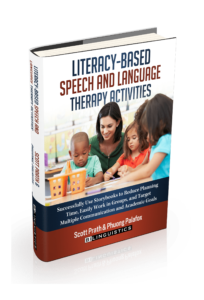 We are great at speech therapy planning but what if we could magically triple our therapy time for the same amount of effort?
We are great at speech therapy planning but what if we could magically triple our therapy time for the same amount of effort?
I feel like this should be an infomercial but read on, it’s really true!
We spend a great deal of time planning for our therapy and as soon as the session is over, we’re done. On to something new! However, by milking a book for what it’s worth we can create a ton of pre-reading activities that the kids REALLY NEED. Then by milking the story for what it’s worth (again), we can create a whole host of post-reading activities that kids ALSO REALLY NEED. Read on…
Pre-reading activities
Pre-reading activities engage the student prior to reading the story, preparing them to comprehend the story in a more meaningful manner. Pre-reading activities are used to bridge any gaps between a student’s current skills and the targeted skills.
Here is why we say that it is something a kid REALLY NEEDS. When we work with diverse populations we can’t make any assumptions about whether the child knows the stories, has books at home, has literate parents… By creating pre-reading activities we can rule out these possible influences so that we can concentrate strictly on the disordered areas.
Speech therapy planning for pre-reading activities:
- Music – use songs semantically related to the material in the book (Hoggan & Strong, 1994).
- Semantic mapping/graphic organizers – the educator works with students to develop a list of words and concepts related to the story and then create a visual representation or map of how the words and concepts are related to one another (Gillam & Ukrainetz, 2006; Hoggan & Strong, 1994). Semantic maps can be used in conjunction with scaffoliding techniques to increase semantic and syntactic complexity (Gillam & Ukrainetz, 2006).
- Pre-reading discussion – Pre-reading questions are designed to tie the students’ knowledge and ideas from the graphic organizer to the concepts in the book.
- Illustration discussion – The student creates a story using illustrations from the selected book. Scaffolding techniques may be used to facilitate higher semantic and syntactic complexity.
- Sound production practice– The student practices commonly occurring words from the selected book. This allows opportunities for specific teaching of certain sound productions prior to generalizing the word or sound into the context of a story.
Post reading activities
Post-reading activities target specific speech and language skills in a context-rich manner, while allowing the student to review what he or she has learned. Post-reading activities provide students an opportunity to review and reflect on what they have learned. For students with language difficulties, post-reading activities are a powerful way to allow the student to experience success that they may not often feel in the classroom.
Again, here is why we say a child REALLY NEEDS post reading activities. Our students rarely get to answer questions correctly and don’t often know the answers like their always-ambitious classmates. If you taught them a story they finally know something and can answer questions! Post-reading activities give them a chance to demonstrate their knowledge and share in front of their peers.
Speech therapy planning for post-reading activities
- Discussion questions – The educator and student discuss the story. Gillam and Ukrainetz (2006) proposed that educators should respond to 40% to 60% of all questions with scaffolding techniques.
- Grammar activities – Students create grammatical structures through a variety of art activities and games. Suggested targets: past tense and present progressive verbs.
- Vocabulary activities – Students add to their word books through art activities in the areas of object/function, part/whole, categories, antonyms, and synonyms. Suggested targets: comparison, categories, and action words.
- Narrative retelling – Students retell the story with the support of scaffolding techniques and visuals from the book.
- Sound practice – Students practice sounds by using images from the book. Theme-related images can also be used to target specific sound productions. You will find a list of words related to this storybook’s theme in the Word Lists by Sounds section.
Conclusion
Expansion of intervention in this manner provides greater familiarity and exposure to concepts that will increase success in the classroom. In addition to being used as general educational tools, storybooks are effectively used in speech-language intervention and other interventions. They provide an excellent structure for teaching concepts, and their repetition and formulaic patterns can aid in retention and retrieval of new information. Storybooks can be selected to address any speech and language goal from sound production to discourse, as well as to address the general education curriculum. From a practical perspective, storybook activities are fun and can reduce planning once the initial materials are created. Books also provide structure for parents to reinforce skills in the home.

Cheers!
References
Content for this essay adapted from Literacy-Based Speech and Language Activities. Use it to learn how to create powerful language therapy using predictable books.
Beckwith, L. & Cohen, S.E. (1989). Maternal responsiveness with preterm infants and later competency. In M.H. Bornstein (Ed.). Maternal responsiveness: Characteristics and consequences: New directions for child development (pp. 75-87). San Francisco: Jossey Bass.
Dempsey, I., & Dunst, C.J. (2004). Help-giving styles as a function of parent empowerment in families with a young child with a disability. Journal of Intellectual and Developmental Disability, 29, 50-61.
Frey, K. S., Fewell, R. R., & Vadasy, P. F. (1989). The relationship between changes in parental adjustment and child outcome in families of young handicapped children. Topics in Early Childhood Special Education, 8, (4), 38-57.
Krauss, M.W. (1993). Child-related and parenting stress: Similarities and differences between mothers and fathers of children with disabilities. American Journal on Mental Retardation, 97, (4), 393-404.
Tomasello, M., & Farrar, MJ. (1986). Joint attention and early language. Child Development, 57(6), 1454-1463.
Rogoff, B. (1990). Apprenticeship in Thinking. Oxford: Oxford University Press.
Rosetti, L. (2006). The Rosetti infant-toddler language scale. East Moline, IL: LinguiSystems, Inc.
Vygotsky, L.S. (1967). Play and its role in the mental development of the child. Soviet Psychology, 5, 6-18.
Also, ASHA is also looking for strategies like this. Here is what they have to say about caseload and workload levels.


 We are great at speech therapy planning but what if we could magically triple our therapy time for the same amount of effort?
We are great at speech therapy planning but what if we could magically triple our therapy time for the same amount of effort?



Do you have a reference list? I would be interested in reading some of the mentioned citations.
Hi Liz,
Thanks for the comment. I added the references for this work into the end of the post. I will be presenting on this topic for the state conference in the spring so I hope to get a presentation and video examples together on this topic soon!
Thank you! I love this blog. Do you have the Gillam and Ukrainetz reference? I would really like to find that one.
Happy to hear you love the blog. Please share it with your colleagues.
Here is the cite and link to a book:
Gillam, R. B., & *Ukrainetz, T. M. (2006). Language intervention through literature-based units. In T. M. Ukrainetz (Ed.), Literate language intervention: Scaffolding PreK-12 literacy achievement (pp. 59-94). Austin, TX: Pro-Ed
Contextualized language intervention: Scaffolding PreK-12 literacy achievement